In the midst of my travels through the diverse and rich culinary landscape of Spain, I was fortunate enough to savor the hearty comforts of Fabada Asturiana. This traditional stew, a beloved gem from the Asturias region, captivated me with its robust blend of lima beans, pork loin ribs, and chorizo sausage. These core ingredients, simmered slowly together, create a dish that is deeply flavorful, with the creamy texture of the beans contrasting beautifully against the savory richness of the pork and the spicy notes of the chorizo. Each spoonful offered a taste of the Spanish countryside, enveloping me in warmth and tradition. Motivated by this gastronomic discovery, I embarked on a quest to recreate Fabada Asturiana at home. After experimenting with various techniques and proportions, I succeeded in capturing the essence of this comforting dish. Now, it is with great excitement and a touch of nostalgia that I share this beloved recipe, inviting all to experience the rustic charm and heartwarming flavors of Fabada Asturiana.
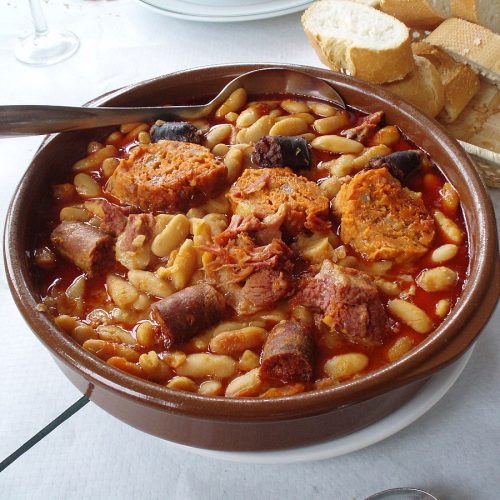
Fabada Asturiana
Equipment
- 1 big saucepan
Ingredients
- 1 tablespoon Spanish paprika
- Salt to taste
- 1 bay leaf
- 6 to 7 ounces chorizo sausage
- 1- pound dry lima beans
- 1 tablespoon extra-virgin olive oil
- 4 cloves garlic
- 1 yellow onion
- 1-1/2 pounds pork loin ribs
Instructions
- Fill a big saucepan or dish halfway with cold water and add the beans.
- Set the burner to high and wait for the water is boiling.
- Turn off the heat after 1 minute of boiling.
- Heat olive oil in the base of a big saucepan over medium heat.
- Add the remaining onions, cloves, and pork when the pan is heated.
- Remove the beans from the water and drain them.
- Combine the beans, sautéed onions, and meat in a big saucepan.
- Cover with water. Add the lemon zest, chorizo slices, and paprika from Spain.
- Return the pan to the burner and set the heat to high.
- Reduce the heat to medium after the water has reached a boil.
- Boiling water should be kept at a low temperature.
Cooking tips about Fabada Asturiana
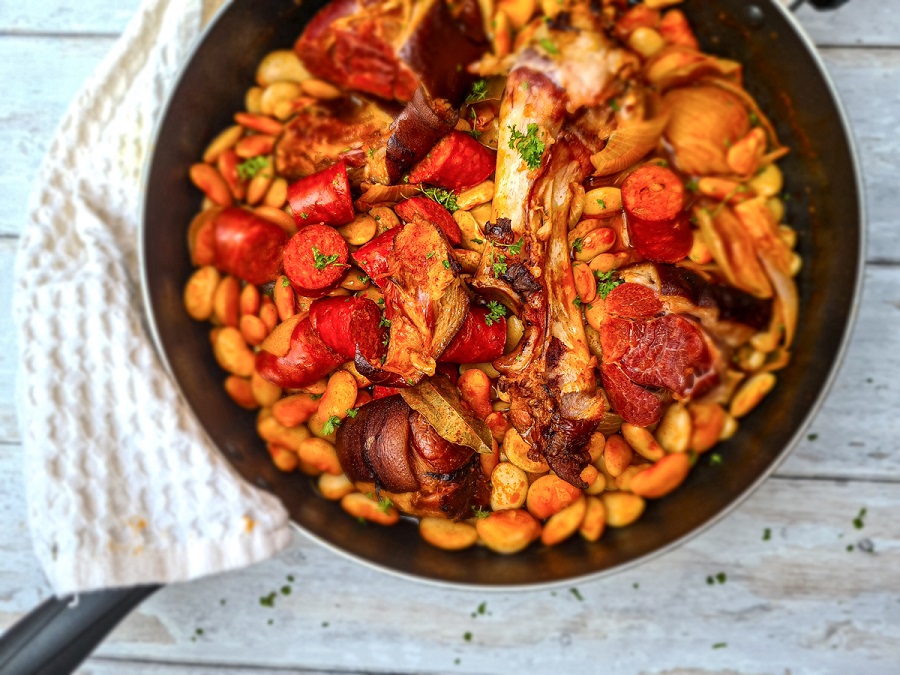
- Quality Ingredients: The foundation of Fabada Asturiana lies in its ingredients. Select high-quality dry lima beans (fabas), Spanish chorizo, morcilla (blood sausage), and pork loin ribs. The authenticity and depth of the dish rely heavily on the caliber of these core components.
- Soaking the Beans: Begin by soaking the dry lima beans overnight in cold water. This step is crucial for softening the beans and reducing the overall cooking time, ensuring they cook evenly and absorb the flavors of the broth effectively.
- Layering Flavors: Start with a sofrito base if desired, sautéing onions, garlic, and paprika to create a flavor foundation before adding the meats and beans. This technique layers the flavors and adds complexity to the dish.
- Low and Slow Cooking: Fabada Asturiana benefits from a long, slow simmering process. Cook the stew over low heat to allow the flavors to meld together beautifully, and the beans to become tender without falling apart. This gentle cooking method also ensures the meats are perfectly tender.
- Adjusting the Liquid: Keep an eye on the liquid level as the fabada cooks. The beans should be covered at all times, so add more water or stock as needed. However, the final stew should not be overly watery but rather have a rich and slightly thick consistency.
- Seasoning: Be cautious with salt in the early stages, as the chorizo and pork can release a significant amount of salt into the stew. Adjust the seasoning towards the end of cooking after the flavors have developed.
- Resting Time: Like many stews, Fabada Asturiana benefits from resting time after it’s finished cooking. Allowing it to sit for a few hours or even overnight lets the flavors deepen and merge, providing a more cohesive and intense taste.
- Serving: Traditionally, Fabada Asturiana is served as a standalone meal with crusty bread on the side. It’s a filling, comforting dish perfect for colder months and exemplifies the heartiness of Spanish cuisine.
- Accompaniments: Though often enjoyed on its own, consider serving the stew with a side of asturian cider or a robust red wine, which complement the rich flavors of the dish well.
Serving suggestions about Fabada Asturiana
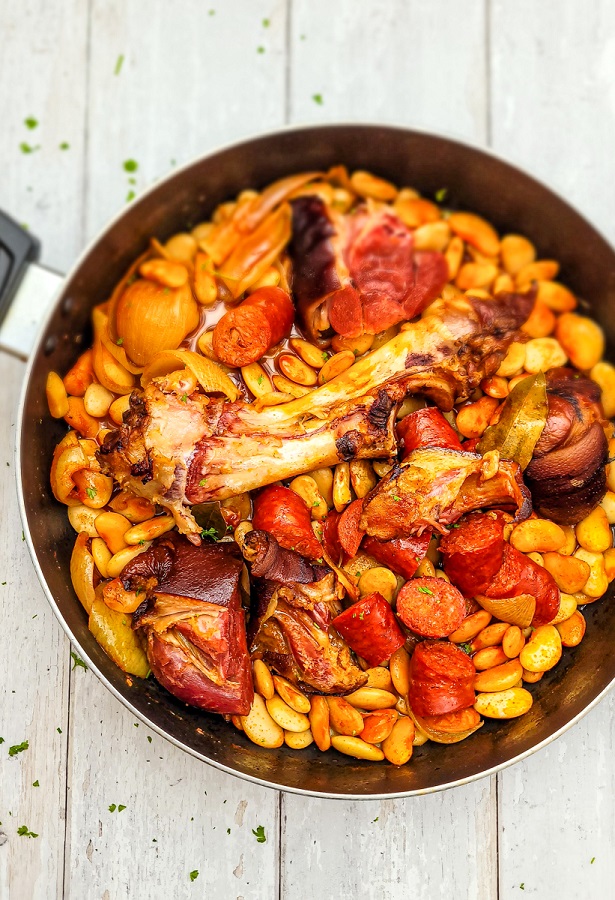
- Authentic Accompaniment: Traditionally, Fabada Asturiana is enjoyed with a side of crusty bread, perfect for sopping up the flavorful broth. Offering freshly baked, rustic bread can enhance the overall experience, allowing guests to appreciate the stew’s depth of flavor fully.
- Pair with Asturian Cider: In its home region, Fabada Asturiana is often paired with a glass of traditional Asturian cider. This beverage complements the rich flavors of the dish with its crisp, refreshing taste. If Asturian cider is hard to come by, a dry cider or a light-bodied red wine also pairs wonderfully, balancing the hearty nature of the stew.
- Appropriate Setting: Considering the richness and heartiness of the dish, it’s ideally served during cooler months or as a fulfilling dinner. Presenting Fabada Asturiana in a communal pot can emphasize the sharing aspect of the meal, inviting everyone to dig in and enjoy together.
- Follow with a Light Dessert: After such a robust main course, opt for a light and refreshing dessert. A simple Spanish flan or a fruit sorbet could provide a sweet note without overwhelming the palate.
Top 5 FAQs about Fabada Asturiana
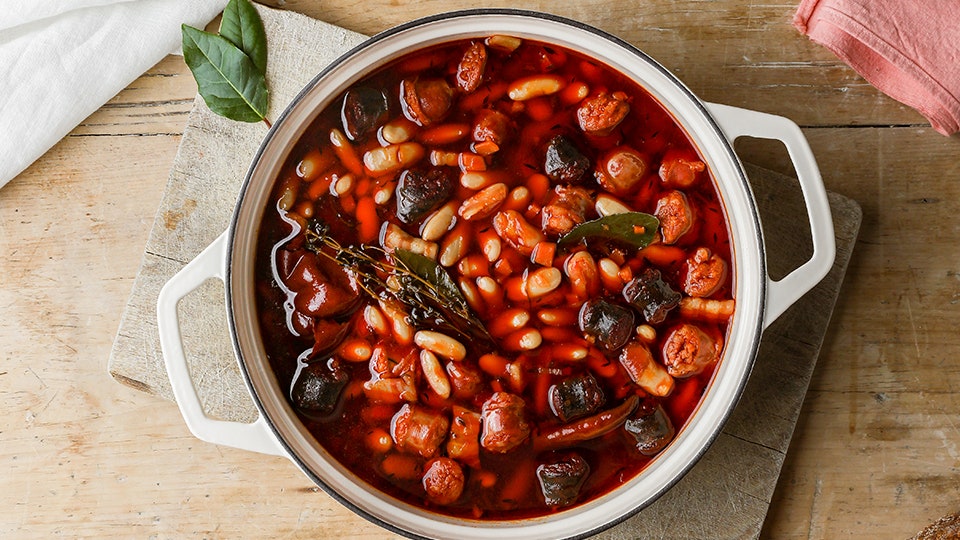
- What is Fabada Asturiana? Fabada Asturiana is a traditional stew from the Asturias region in Spain, celebrated for its rich and hearty flavors. It consists of lima beans, pork loin ribs, chorizo sausage, and sometimes morcilla (blood sausage), simmered together to create a comforting and flavorful dish.
- What are the key ingredients in Fabada Asturiana? The essential ingredients that define Fabada Asturiana include dry lima beans (fabas), Spanish chorizo, pork loin ribs, and often morcilla. These components are slowly cooked to meld the flavors, with the beans providing a creamy texture that contrasts with the savory meats.
- How should I cook Fabada Asturiana for the best results? To achieve the best results, start by soaking the lima beans overnight. Cook the dish low and slow, allowing the flavors to develop fully. Maintain enough liquid to cover the beans, but aim for a thick consistency in the final stew. Adjust seasoning towards the end to account for the salt released by the pork and chorizo.
- Can Fabada Asturiana be made in advance? Yes, like many stews, Fabada Asturiana actually benefits from being made in advance. Allowing it to rest for a few hours or even overnight deepens the flavors and enhances the overall taste, making it an ideal make-ahead meal.
- What is the best way to serve Fabada Asturiana? Traditionally, Fabada Asturiana is served as a standalone main course, accompanied by crusty bread to soak up the delicious broth. It’s a filling dish, perfect for colder months, and captures the essence of Spanish communal dining. Pairing it with Asturian cider or a robust red wine can complement the rich flavors beautifully.
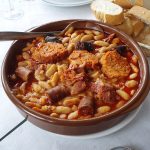
Leave a Reply